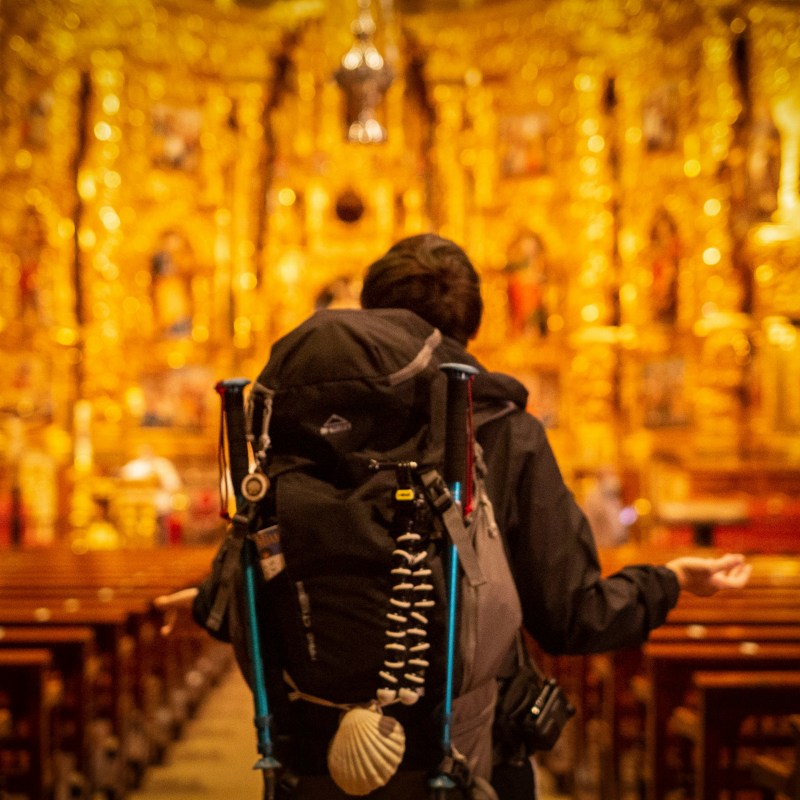
Ever heard of the Camino de Santiago?
Videos by TravelAwaits
If you have a background in travel, European history, or Catholicism, you’ve probably heard of it once or twice.
The Camino de Santiago is a thousand-year-old pilgrimage route that leads to a church in Galicia where the remains of Jesus’s Apostle James are (allegedly) buried.
The most well-known Camino de Santiago cuts through Northern Spain toward its western Galician coast. That’s where the church is located in a city called Santiago de Compostela
In reality, however, the modern ‘caminos’ are the result of medieval routes. Back in the 800s when pilgrims first set out to see the remains of Saint James, they would simply pack their bags and head off.
Over the course of centuries, hundreds of thousands of pilgrims tread impromptu trails. These are remembered today as the ‘Camino Frances’, ‘Camino Portugues’, and other specific trails that are clumped under the ‘Camino de Santiago’.
And while the Camino might sound like a long-lost relic of medieval Catholicism, it’s spiking in popularity.
Back in the summer of 2022, around 1,000 pilgrims were arriving daily to receive official certificates that they’d completed the route. That’s the highest number on record in recent years.
What’s going on with the sudden interest in the Camino? Are its travelers mostly pilgrims or are they taking the Camino for historical intrigue? Let’s explore.
Rise of the Camino
I hate to burst anyone’s religious bubble, but most of the Camino de Santiago is based on existing Roman trade routes that cut through the continent.
Catholicism also spread along these trade routes. By the 800s, most of Western Europe was staunchly under the influence of the Pope. Word began to spread that the relics of Saint James, an actual apostle of Jesus Christ, were being stored at a church in the city of Santiago de Compostela.
It didn’t take long for pilgrims to set off.
And given Europe’s rather tight focus on Catholicism throughout the Middle Ages, the Camino steadily gained notoriety.
By the 1200s, the Pope was funding hospitals, lodgings, and other resources for pilgrims who were traveling from as far as Poland and Romania.
In fact, a handful of towns along the route still contain the word ‘hospital’ because they were created around medical facilities built for pilgrims. (Looking at you, Hospital de Orbigo.)
There were even souvenir shops on the Camino—some of the very first prototypes of the modern gift shop. In fact, medieval Europeans flocked to the cathedral in such numbers that, in modern Spanish, the Milky Way is known as the Santiago de Compostela.
This came about because the galaxy was rumored to be formed by the dust kicked up by feverish pilgrims heading on the Camino.

Expanding beyond spirituality
By the time most medieval pilgrims reached the cathedral of Santiago de Compostela, they were a little worse for wear. Over the decades, new paths started to pop up, offering pilgrims alternative routes.
More relaxing and safe routes, specifically.
But by the 1800s, it had fallen out of favor. Few remembered the Camino aside from those still living along the route. Not even the Catholics.
Until the mid-1900s.
In 1957, a traveler penned the book The Road to Santiago, which helped put the Camino back in the public eye. The work helped generate new interest in the Camino.
Unfortunately, so did Spain’s former dictator Francisco Franco. His far-right agenda placed a hefty emphasis on the country’s Catholic history and legacy.
By the 1980s, the Camino had taken on a reputation as a travel route just as much as a pilgrimage. Though Catholics today still head on the Camino in search of penance, modern interests are more focused on the trail’s legacy, site-seeing, and historical landmarks.
So, if you’re interested but don’t have your sacraments, you’re still more than welcome.
What can you expect?
As mentioned throughout, you’ll have choices about which ‘Camino’ to take.
The most popular is the Camino Francés, which starts in southern France, cuts through the Pyrenees, and then heads west to Galicia.
Though it’s not the oldest route, it was also the most popular during the Medieval era, as most pilgrims came from France. This route is around 500 miles long.
Another popular route is the Camino Portugués, which starts in either Lisbon or Porto. Once again, many pilgrims from the Middle Ages came from Portugal. However, there aren’t nearly as many historical sites compared to the Camino Francés.
Along the way, subsidized hostels and lodgings offer pilgrims shelter. Many monasteries along the way also provide free accommodation and meals to pilgrims.
Those who plan on doing this should purchase a ‘credencial’ or pilgrim passport, which allows you to document the journey and the landmarks you see.
It’s also necessary proof to get the Compostela—a certificate from the Catholic Church that states that you completed the pilgrimage.
